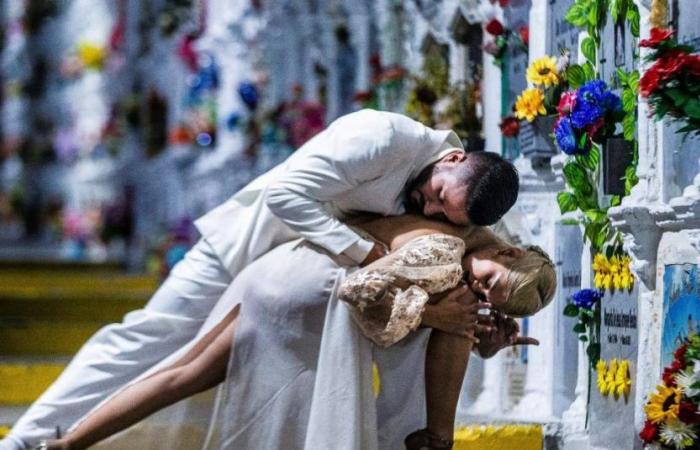08:48 PM
Death and its creative force. The death of Carlos Gardel 89 years ago gave rise to the flame of tango in Medellín with its inexhaustible forms of beauty, like dance, with which María Alejandra and Santiago transformed the pain of death into a way of saying a lot of things in a language more universal than words.
María Alejandra Ospina and Santiago Salazar Botero, two twenty-somethings from Manrique and Robledo, consecrated themselves this week at the International Tango Festival with a choreography with which they sought, needed, to transform the pain of an absence into art and movement. They chose a tango by María Graña’s teacher, Without your half, in which that torn voice speaks of an indivisible sadness and asks how to fill with nothing the void of an other half that is no longer there.
Dancing that sadness they managed to connect with an audience that applauded them with tears and a jury that, rather than congratulating them, thanked them for “that breath of art.”
But María Alejandra and Santiago had another special date after that consecration. On the cold night of last Thursday, dozens of people gathered at the San Pedro cemetery to invoke the spirit of Gardel, his sounds and footprints. Zorzal’s body was in San Pedro for six months from June 26, 1935, after the plane crash that wiped out the church. the voice that UNESCO declared two decades ago as the guardian of the world’s memory.
On December 17 of that same year, his remains left their temporary grave to embark on a journey that took them to La Pintada and Caramanta and then from there on mule back to Riosuciowhere a truck took the bones to Armenia and later they were shipped by train to the port of Buenaventura, where a ship was waiting to take the remains to Balboa, Panama; New York, Rio de Janeiro, Montevideo and finally to his home in Buenos Aires, to finally rest in the Chacarita cemetery in February 1936.
Read also: The story of three illustrious writers who will rest in the San Pedro cemetery
For Santiago, dancing on that night in which the memory of the man who made Medellín the second world capital of tango was honored was being able to close the circle of history that inspired the beautiful and painful dance he created with María Alejandra.
“My grandfather Carlos died two years ago and is buried here. So it was not only the experience of being on a night with so much meaning for tango in Medellín and being able to dance for the first time in a cemetery, but it was also a tribute to my grandfather Carlos,” Santiago said.
It was his grandfather Toca (as he affectionately called him), one of the people who led him towards the paths of tango from a very young age and who precisely inspired him to try to turn pain into an expression of art through dance.
Thus, Santiago and María Alejandra danced throughout San Pedro; They merged, they separated, they consoled each other and They re-emerged among flowers, vaults, names and absences. And not even the rain could stop them, as they also danced under the shelter of the chapel.
“It was a magical moment because it was like confirming that death can bring forth something as alive as dance,” recalled Santiago, a frequent visitor to San Pedro, where he says he has found some answers about death and has dismantled many taboos surrounding it.
And whether it is to the sound of tango, the warmth of the fire, the rhythm of a collective night walk, a chat over the taste of a red wine or the pulse of painful and necessary nights of writing letters to the dead, the San Pedro cemetery has become the quintessential place in Medellín for direct and difficult conversations about death. And it has done so with two objectives: to help people heal and to learn to live with death as an everyday reality full of meaning, far from the mere fatalism that Western culture has generally tried to give it.
Meet the Gardel who was born in Medellín
María Alejandra and Santiago, teachers and dancers from the Chetango academy, will take their dance to Buenos Aires for the World Tango Championship where they will represent Colombia next August. They will also be in Chile and several cities in Colombia.
As for Gardel, he is still more alive than ever. The International Tango Festival confirmed that it was the excuse for Medellín to shout to the world that Gardel never left here. The thousands of children who sing and dance tango in the city also declare it. Medellín recently opened the first tango music school in the country.
Next year will be 90 years since Gardel’s physical disappearance and again it will be the opportunity for Medellín to revive the symbiosis that teacher María Graña talks about in her song, the symbiosis of this city with that sad thought that is danced.


